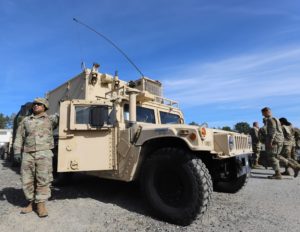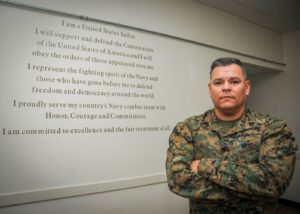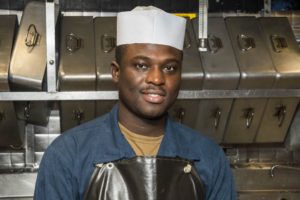Any month is a good month for celebrating our men and women in uniform, but the month of July, with its prevailing mood of patriotism, makes this an especially fitting month. On past occasions, PB Oil and Gas Magazine has celebrated the lives of military veterans working in oil and gas jobs in our region. This time we take a look at active duty servicemen. These vignettes are from public relation arms of our armed forces.
Odessan takes part in V Corps certification

Army Staff Sgt. Francisco Franco, from Odessa, Texas, waits to transport essential equipment for the Warfighter 22-1 exercise in Grafenwoehr, Germany, Oct. 1. PHOTO BY PFC DEVIN KLECAN.
Army Staff Sergeant Francisco Franco, who hails from Odessa, is one of many sons of the Permian Basin who serve our nation by doing their duty in a branch of the U.S. Armed Forces. Franco was privileged to be part of a historic operation in Europe last fall. He pulled duty in the task of certifying V Corps, the United States’ new forward-deployed corps in Europe.
This joint exercise also saw the participation of the Air Force, as the 505th Command and Control Wing supported the U.S. Army’s Mission Command Training Program. The result was the validation of Victory Corps as a European Command allocated corps headquarters during the execution of Warfighter exercise 22-1 at Grafenwoehr, Germany, Sept. 27-Oct. 5.
The multi-component exercise, which had the main command post at Grafenwoehr, Germany, a rear command post at Fort Riley, Kansas, and a U.S. Air Force Air Component and Air Operations Center replication cell at Hurlburt Field, Florida, tested the V Corps’ ability to mission command large-scale combat operations, or LSCO, in a multi-national environment.
The mission command proficiency of 1,402 joint service personnel, including soldiers from U.S. Army Europe and Africa, V Corps, 3rd Infantry Division, 34th Infantry Division, and their respective subordinate units, was tested and honed during the execution of WFX 22-1.
Warfighter exercises are distributed, simulation supported, multi-echelon, tactical command post exercises fought competitively against a live-thinking regional adversary in a complex environment to prepare units for future LSCO.
“The warfighter [exercise] is rigorous, complex, and very time-intensive. It is a nine-day sprint in large-scale ground combat operations. It’s the only time our corps and divisions are collaboratively immersed against a near-peer competitor, where they’re forced to really understand and improve their wartime mission,” said U.S. Army COL. Robert Molinari, chief of operations Group A, Mission Command Training Program, U.S. Army Combined Arms Center.
A substantial part of any Warfighter exercise is replicating the air component; this mission is the responsibility of the U.S. Air Force’s 505th CCW, Detachment 1, based at Fort Leavenworth, Kansas. This total force integrated unit’s mission is to provide airpower expertise and exercise support to the U.S. Army’s MCTP and act as the U.S. Air Force’s Air Warfare Center liaison to the U.S. Army’s Combined Arms Center.
“This was probably the most significant air component replication for a WFX that we’ve done to date,” said U.S. Air Force Col. Michael Goodman, 505th CCW, Det 1 commander. “V Corps did a great job. They gave 110 percent daily. They were receptive to coaching and observations and every single day, across the board, they got better,” said Molinari. “So, I think it was a fantastic opportunity for V Corps to really see themselves, to improve on, and to prepare for what the Army might ask of them.”
Marine continues 75 years of Seabee tradition
“We Build, We Fight” has been the motto of the U. S. Navy’s Construction Force, known as the “Seabees,” for the past 75 years. Roswell, N.M., native and Roswell High School graduate, Marine Corps Staff Sergeant Michael Bachicha, builds and fights around the world as a member of a naval construction battalion center located in Port Hueneme, Calif.
Bachicha is a Marine currently serving as a military advisor for the Navy Seabees.
“As a Marine serving with the Navy Seabees, I provide advice on the infantry tactics to help them set up their defenses including how to employ their machine guns and set up fighting positions,” said Bachicha.
The jobs of some of the Seabees today have remained unchanged since World War II, when the Seabees paved the 10,000-mile road to victory for the allies in the Pacific and in Europe, according to Lara Godbille, director of the U. S. Navy Seabee Museum.
“I like working with the Seabees because they want to learn about military tactics,” said Bachicha. “I also respect the pride they have in the jobs they do.”
Serving with the U.S. Navy has allowed Bachicha to continue learning about himself and the legacy he wants to leave to future Seabees.
“The Seabees are a huge part of our military history and I’m honored to be part of this unit now so I can celebrate with them,” said Bachicha.
Midland native serves aboard U.S.S. Essex
A Midland, Texas, native is serving aboard USS Essex, a U.S. Navy Wasp class amphibious assault ship. Airman Apprentice Olawale George attended University of Houston-Victoria. Today, George serves as a aviation support equipment technician.
“Aviation support equipment technicians manage and maintain almost all support equipment necessary for the smooth running and repairs of the United States Navy’s aircraft,” said George.
George joined the Navy a year and a half ago to serve the country.
“I joined the Navy for the numerous benefits the military offers,” said George. “I also looked forward to the prestige of service to the country and myself. I also knew that joining the Navy would expose me to countries I never would have dreamed of visiting on my own.”
According to George, the values required to succeed in the military are similar to those found in Midland.
“My hometown taught me that dedication and discipline will help you achieve your dreams,” said George.
Homeported in San Diego, California, USS Essex is the second ship in the Wasp-class of multipurpose amphibious assault ships and the fifth ship named for Essex County, Massachusetts. Essex was a 1000-ton ironclad river gunboat of the U.S. Army and later U.S. Navy during the American Civil War.
According to Navy officials, amphibious assault ships are designed to deliver U.S. Marines and their equipment where they are needed to support a variety of missions ranging from amphibious assaults to humanitarian relief efforts. Designed to be versatile, the ship has the option of simultaneously using helicopters, Harrier jets, and Landing Craft Air Cushioned, as well as conventional landing craft and assault vehicles in various combinations.
There are many opportunities for sailors to earn recognition in their command, community and careers while serving in the Navy.
“My proudest Navy accomplishment is becoming shipboard qualified,” said George.
As a member of the U.S. Navy, George, as well as other sailors, know they are a part of a service tradition providing unforgettable experiences through leadership development, world affairs and humanitarian assistance. Their efforts will have a lasting effect around the globe and for generations of sailors who will follow.
“Serving in the Navy means service to country and self,” added George.












